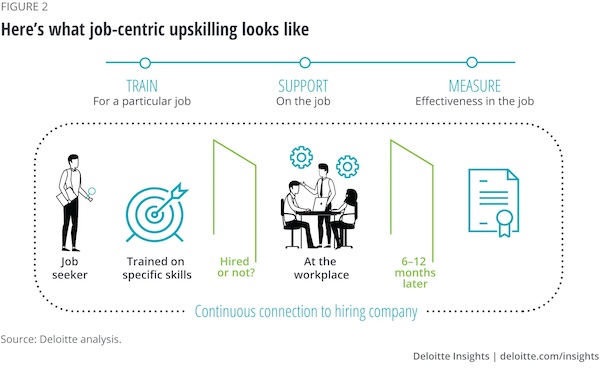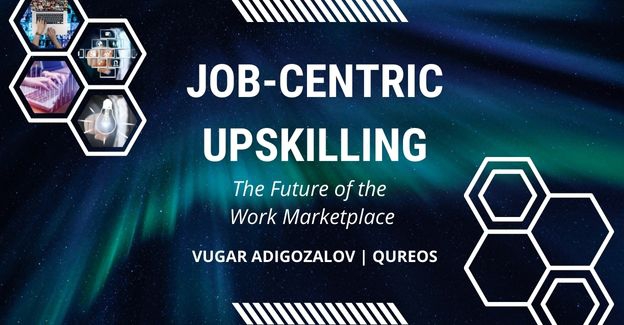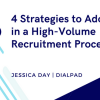Investing in talent reskilling and upskilling will be necessary in the coming years to fill the talent gap says Vugar Adigozalov, Head of Marketing with Qureos. He shares the benefits of skills training for employees and companies, and shares the five forces driving the demand for more technically skilled talent.
The World Economic Forum estimates that more than half of all employees worldwide need to upskill or reskill by 2025 to embrace the changing nature of jobs. According to Harvard Business Review, organizations turn toward reskilling and upskilling to build the talent they cannot acquire or productively deploy. And yet a 2020 global BCG study showed that “talent and skills” was the second-most under-invested area in corporate transformation efforts.
Skills gaps continue to be high as in-demand skills across jobs change in the next five years. The top skills that employers see as rising in prominence in the lead-up to 2025 include critical thinking and analysis, problem-solving and self-management skills such as active learning, resilience, stress tolerance and flexibility. According to The Future of Jobs Report, on average, companies estimate that around 40% of workers will require reskilling in six months or less, and 94% of business leaders report that they expect employees to pick up new skills on the job, a sharp uptake from 65% in 2018.
Five Forces Pushing for Workforce Upskilling
By focusing on job-specific capacities, upskilling can benefit all industry players, including job seekers, companies and the economy by going beyond training and concentrating on specific job capabilities. In recent history, five main forces have pushed the global economy and the future of the work marketplace to invest in talent reskilling and upskilling to meet future demand.
1. AI & Automation
Automation and offshoring were placing jobs at risk—especially for low-wage workers. At the same time, companies were struggling to find the skilled workers they needed to grow. The World Economic Forum expects AI to create more jobs than it destroys, asserting that 133 million new jobs will emerge. Many business executives share the WEF's optimistic view of AI's job-creation potential. Employers have traditionally relied on university graduates and post-graduates for several reasons: to help close talent gaps, bring new knowledge, skills and capabilities to the organization; and as a source of future leaders. However, this traditional approach is no longer enough and colleges and universities cannot produce enough graduates to meet industry needs.
In 2017, the McKinsey Global Institute estimated that as many as 375 million workers –representing 14% of the global workforce – would have to switch occupations or acquire new skills by 2030 because of automation and artificial intelligence.
It's time for companies and individuals to embrace the upskilling imperative. For companies, upskilling enables building a future-ready workforce; it's a way to keep their skills relevant and future-ready. Making deliberate, significant investments in learning will ensure organizations and employees alike have the knowledge, skills and capabilities needed to work effectively in a digitized, automated world, and build and consume AI-powered insights.
Automation, in tandem with the COVID-19 recession, is creating a double-disruption scenario for workers. By 2025, humans' and machines' time spent on current tasks at work will be equal. A significant share of companies also expect to make changes to locations, their value chains and the size of their workforce due to factors beyond technology in the next five years.
2. COVID-19 Pandemic
The COVID-19 pandemic has inadvertently been one of the biggest catalysts for workplace change, creating a mass “experiment” in remote working. The onset of the pandemic in the spring of 2020 prompted massive global economic disruption, with unemployment levels not seen since the 1930s' Great Depression. Even before the COVID-19 pandemic, the U.S. economy faced a skills gap.
Though unemployment was low, many workers struggled in low-wage and "gig" economy jobs. Researchers at the University of Chicago project that 32% to 42% of COVID-induced layoffs will be permanent. While the disruptive shock to the economy was rapid, the shift to new forms of work will evolve.

3. Global Workforce Upskilling Race
The World Economic Forum works with over 350 organizations to provide 1 billion people with better education, skills and economic opportunities by 2030. The ambitious program prepares the global workforce with the skills needed to future-proof their careers, as technologies like AI enable greater automation.
By working together with a growing network of 21 committed ministers in 11 countries, the Reskilling Revolution has mobilized an impressive multistakeholder. Founding members include Adecco, Coursera, Dubai Cares, The Education Commission, the Government of France, iamthecode, Infosys, LinkedIn, ManpowerGroup, PwC, Salesforce and UNICEF.
4. Governments Tackling the Talent Gap
As the tasks of government change, so too will the skill sets needed of government employees. For instance, in the 2020 federal budget proposal, the White House included resources to reskill 400,000 federal workers – about 20% of the workforce – in hard-to-fill roles such as data science, IT and cybersecurity.
As technology advances, governments at all levels are increasingly looking to evolve the skills of their workforce. The U.S. Army is also upskilling civilian workers in the emerging talents of the future. The new program, called Quantum Leap, has an initial plan of retraining about a thousand employees for systems analyst, application developer and data manager roles by 2023.
5. Next-Generation Workforce Providers
Monitor Institute by Deloitte conducted in-depth research for market-driven training and education providers seeking to expand opportunities for the global workforce through upskilling. The report makes four broad recommendations for improving outcomes for workers and employers alike and closing the talent gap:
- Be market-responsive: Providers should develop deep partnerships with companies and tailor programs to employer needs.
- Focus on the "good jobs:" Good jobs are defined as those that meet the distinct needs of participants: their characteristics can include compensation, career growth, economic mobility or flexibility of work schedules. A good job might look different for different demographics.
- Lift untapped talent: Tailored skills training is essential, but it is often critical to provide other “wraparound” supports to help job seekers succeed.
- Invest in organizational capacity: The report urged next-generation workforce providers to build internal capabilities for continuous improvement, use data to measure program quality and tap into unconventional funding sources to boost sustainability.







